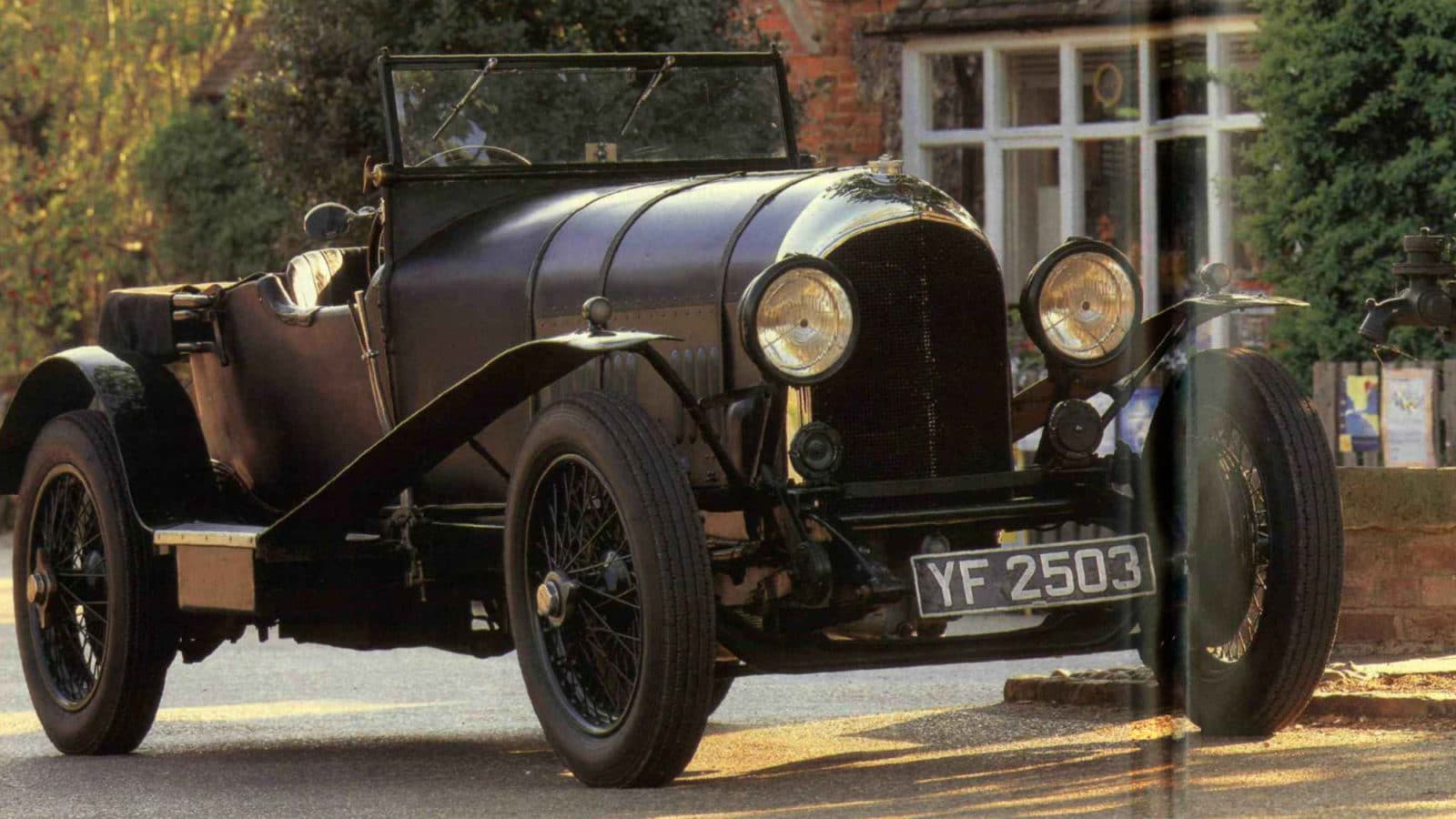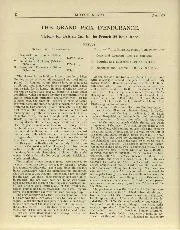All went according to plan right up to the moment when Tabourin, driving a Theophile Schneider crashed heavily at the White House corner. First on the scene was Callingham, driving the 41/2. Desperately he tried to swerve past the wreck hut succeeded only in putting the Bentley in the ditch. Duller, in second place, was the next Bentley through and had the same idea, knowing not that a Bentley already occupied the gap into which he aimed. The 3-litre hit Callingham’s car so hard it forced it out of the ditch, while Duller hurtled into a field, walking away unscratched. Davis was third around the corner. Something, however, had told him all was not right. As he approached the comer, he could see debris and lifted early. Though he was unable to avoid crashing, this move not only saved his car but also Bentley’s pride. He briefly joined Duller in the search for Callingham’s body in the wrecked 41/2 before being greeted by the man himself who had been thrown clear and, unharmed, had run down the road to warn others. Davis extricated himself from the wreckage and limped back to the pits, where the badly bent bodywork was lashed up, and was sent back into the race complete with a severely twisted chassis. All night with just a single headlight and all the following day, Davis and Benjafield drove that Bentley as if it were a five-lap sprint, chasing the leading Aries and its now presumed unassailable lead. They hunted it down, lap by lap until Britain’s victory was assured. Just before the end, Benjafield brought the battered and bloodied Bentley into the pits and charged Davis with delivering the final statement. By the time anyone else won Le Mans again, in 1931, Bentley Motors had ceased to exist.
What, then, is remarkable about Duller’s 3-litre is not its racing history, its highlights being merely to crash at Le Mans, fail to finish the 1928 Essex Car Club six hour race at Brooklands at the hands of William ‘Bummer’ Scott and to deputise for the Le Mans winner in a Davis/Benjafield demonstration run at Shelsley Walsh; it is the fact that it still exists, largely unchanged, today. The winner, the famed ‘Old Number Seven’ was broken up and while bits of it are presumed to exist in various other Bentleys, its own identity has been lost for ever. The 41/2 went on to become perhaps the most famous of all the team cars, winning Le Mans with Woolf Barnato and Bernard Rubin the following year coming second in 1929 and evolving into the Marker-Jackson Special which took the last ever 130mph badge at Brooklands in 1939. Today, ‘Old Mother Gun’ is still actively campaigned by Stanley Mann and Vaughan Davis but whether very much of it actually slid down that ditch seventy years ago is doubtful.
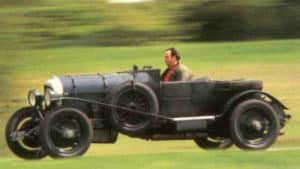
Very rarely these days do you ever find any pre-war car, let alone a Bentley, in such good condition. Its bodywork is ripped and faded, the fuel tank bashed and dented. The eye-holes in the leather straps securing the bonnet arc now long gouges and the coachbuilders plaque is chipped. Money can’t buy the way this car looks. It looks fresh from the battle; stained, worn and ready for anything.
And so it proves. The driving position must have been fine for someone designed to ride horses like Duller but, for me, it’s restrictively tight and not helped by the conventional pedal arrangement. With the central accelerator fitted to all four-cylinder Bentleys, your right leg avoids becoming tangled with the gear-lever. This car is not like that though, looking at the wear patterns on the pedals, it is clear that it has only recently been tampered with.
It makes the process of changing gear trickier still. Bentley ‘boxes are often called all manner of names but, in the main, such criticism is unfair. For sure, the later units fitted to the rare 8-litre and 4-litre cars were unforgiving, but the rest, once you have worked out where the ratios lie, are fine if treated with the correct blend of sympathy and commitment. The racing gearboxes are easier still, their tight ratios allowing much less time for error between changes. The villain is the cone clutch. This great idea in theory has a habit of sticking in practice and is capable of making even the most professionally executed change seem bungling especially if, as in this case, there’s no clutch brake. Starting the old warrior is simplicity itself. Set the hand-throttle, retard the ignition, flick on the magnetos and press the button. The long-stroke, single cam, 16-valve, twin-spark four cylinder engine fires immediately and idles at an unwavering 500rpm. It’s sound is deep and rich and, when you blip the throttle, you can hear the air being sucking into the twin `sloper’ SU carburettors.
We’d originally planned to return to the White House with the Bentley but the scene of the crime, it transpires, no longer exists. So we simply took it from the confines of London and spent the day driving. Free from any such tedious constraint as a destination, we simply roamed around, seeking out the good roads where, once more, this great car could roar the glories of its past.
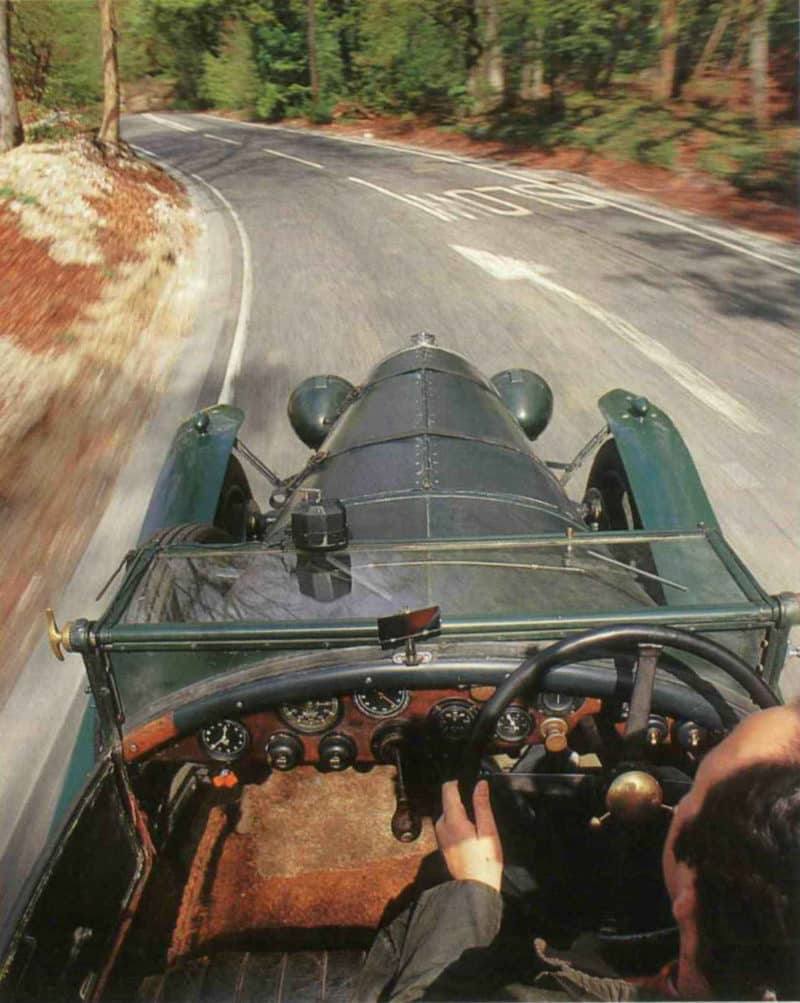
Windscreen laid flat, huge wheel in hands, this is pure motoring pleasure. Note manual fuel pressure pump
And not once were we overtaken. Even so, it’s a car which needs thought to be driven swiftly, sensitively and safely. The old notion with vintage Bentleys that you only have to reach top gear and the torque will do the rest does not apply to the 3-litres. You need to use the gears and make the ratios work to your advantage. First to second is long, second to third super-short and third to fourth longest of all. You also have to watch the revs. Duller would probably have changed at around 3500rpm but, on the road, there’s neither call for nor advantage to be gained from such treatment. Using 2800rpm is enough to call up 80mph on the clock which is about as much as your face will stand if you’re stupid enough to choose to trawl with the windscreen laid flat across the bonnet.
There are two surprises. First, the handling is a delight, better by far than the bulk of the heavier Bentleys that followed. It’s light and nimble in a way that you simply don’t expect from any car that first saw light in Cricklewood, turning into corners with none of the nose-heaviness I’d expected. The steering is terrific, linear in its response in a way so different to the only other 3-litre I’ve driven that I wondered whether it had acquired the rather better system from the 41/4-litre model at some stage. Doubtless, however, one of the main reasons for the chassis’ response is the fact that it is running on tall, 21in wheels fitted with skinny 5.00in road tyres. So many these days are found running around on 19 x 6.00in racing rubber and it is a pleasure to see and drive a car such as this in its original specification. It may not be the grippiest thing on the road but that, in fact, only adds to the pleasure.
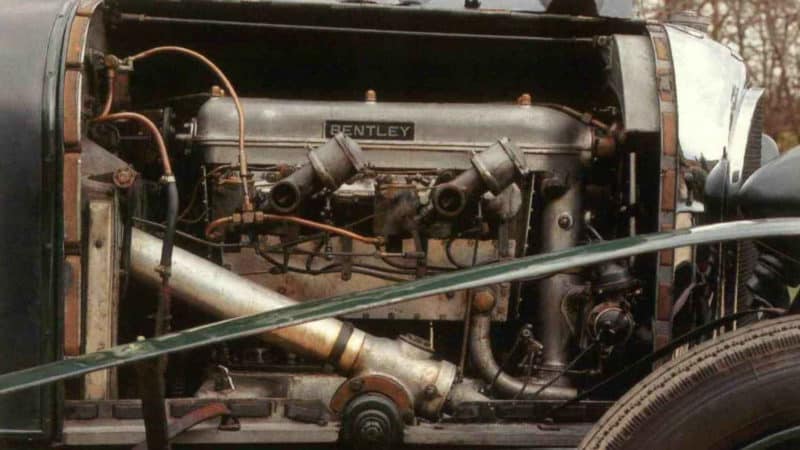
Sadly not original AX1675 engine but earlier HP379 unit instead. Specification is correct. Radiator should be nickel, not chrome
The other surprise is the brakes which, sadly, are barely adequate. You need to maintain gaping distances if they are to be relied upon, and to know where the handbrake is to help shed speed when those who do not understand the space such cars need leap out in front of the old car they erroneously believe will otherwise hold them up. Bentley knew of their limitations and for the 41/2-litre model, beefier and more effective drums had been fitted.
All too soon, my day with Bentley’s team 3-litre is over. By the time you read this it will have been sold at auction by Brooks and will be in the hands of its ninth owner who, I hope, will put the pedals back where they belong.
This is such an important car, so rich and vital a strand of Britain’s motoring history that there must always be a temptation to lock it away to preserve its originality for all time. I hope its new custodian resists it. Vintage Bentleys arc neither art nor exhibit and this one, of them all, was built to be driven hard and fast. I’d like to wish whomsoever had their hand still the air when the gavel came clown a lifetime’s fast motoring in this most important and precious car.
Our sincere thanks to Brooks Auctioneers (0171 228 8000) for its help in making this feature possible
